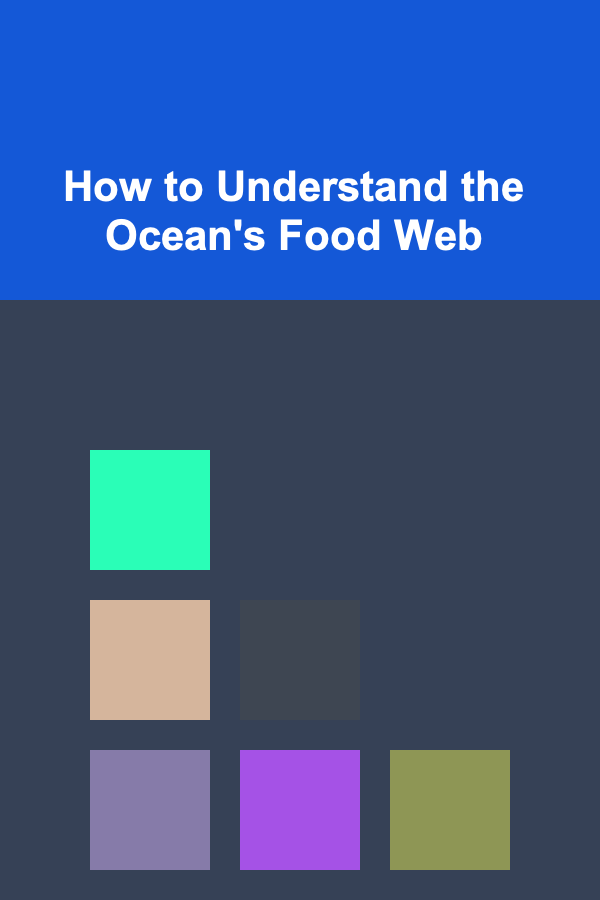
How to Understand the Ocean's Food Web
ebook include PDF & Audio bundle (Micro Guide)
$12.99$7.99
Limited Time Offer! Order within the next:

The ocean is one of Earth's most critical ecosystems, a vast and complex environment teeming with life. From the smallest plankton to the largest whales, the ocean's inhabitants form intricate relationships, one of the most fundamental being the food web. This concept describes the feeding relationships between various marine organisms, showing how energy is transferred through the system. Understanding the ocean's food web is not only vital for marine biology but also for the health of our planet's ecosystems.
In this article, we will explore the structure and components of the ocean's food web, the different levels of organisms within it, how energy flows through the system, and the impact human activity has on it. We will also look at the importance of preserving the ocean's food web for the future of marine life and human existence.
What is a Food Web?
A food web is a network of interconnected food chains within an ecosystem. It represents the various feeding relationships in a specific environment and demonstrates how energy and nutrients flow between different species. Unlike a simple food chain, which shows a linear sequence of who-eats-who, a food web includes multiple interconnected chains, reflecting the complexity of nature.
In the ocean, the food web is particularly intricate due to the immense diversity of organisms, from microscopic plankton to large marine mammals. The interconnectedness of these organisms means that changes in one part of the web can have far-reaching effects throughout the entire ecosystem.
Key Components of the Ocean's Food Web
Understanding the ocean's food web requires knowledge of the different levels of organisms within it. These levels are classified based on how they obtain energy, and they range from producers to top predators.
2.1. Primary Producers
At the base of the ocean's food web are the primary producers, organisms that create their own food through photosynthesis or chemosynthesis. These organisms form the foundation of the entire ecosystem.
- Phytoplankton: Tiny, microscopic plants, phytoplankton are the most abundant primary producers in the ocean. They perform photosynthesis, converting sunlight into energy, and are responsible for producing a significant portion of the Earth's oxygen. Phytoplankton are crucial in supporting marine life as they are the primary food source for many marine organisms, including zooplankton, small fish, and other marine creatures.
- Macroalgae and Seagrasses: Larger plants like kelp forests and seagrass meadows also play a key role in the food web. These plants are not only primary producers but also provide habitat and shelter for numerous marine species, including fish and invertebrates.
- Chemosynthetic Bacteria: In environments such as hydrothermal vents, where sunlight is absent, certain bacteria use chemical energy from the Earth's crust to produce food. These bacteria are the foundation of a unique food web in these extreme environments.
2.2. Primary Consumers (Herbivores)
Primary consumers are organisms that feed on primary producers. In the ocean, this typically includes small herbivores that consume phytoplankton or algae. These consumers are vital in transferring energy from producers to higher trophic levels.
- Zooplankton: These tiny, often microscopic organisms feed on phytoplankton and form an essential part of the diet of many larger animals in the ocean. Zooplankton are an important food source for small fish, which in turn are eaten by larger predators.
- Herbivorous Fish: Larger herbivores, such as certain species of fish, feed directly on algae or seagrass. Examples include parrotfish, which graze on coral reefs, or certain species of manatees, which consume seagrasses.
2.3. Secondary Consumers (Carnivores)
Secondary consumers are organisms that feed on primary consumers. These include small to medium-sized fish and other marine animals that primarily consume herbivores and zooplankton.
- Small Fish: Many fish species, such as anchovies, sardines, and herring, are secondary consumers. They feed on zooplankton and are, in turn, preyed upon by larger fish and marine mammals.
- Invertebrates: Invertebrates like squid, octopuses, and crabs are secondary consumers that feed on a variety of smaller organisms. These species are important players in the food web, both as predators and prey.
2.4. Tertiary Consumers (Top Predators)
Tertiary consumers, also known as apex predators, are at the top of the ocean's food web. They feed on secondary consumers and often have few or no natural predators themselves. These animals play a crucial role in maintaining the balance of the ecosystem.
- Large Fish: Certain fish species, such as tuna, sharks, and groupers, are apex predators in many marine environments. They control the population of smaller fish and other organisms, preventing any one species from becoming too dominant.
- Marine Mammals: Whales, dolphins, and seals are often at the top of the food web in marine environments. These animals can be generalists, eating a variety of prey, from small fish to krill.
- Seabirds: Seabirds like albatrosses and penguins are also important apex predators, feeding on fish, squid, and other marine organisms. While they are not necessarily at the top of every food chain, they often play key roles in coastal and open-ocean ecosystems.
Energy Flow Through the Food Web
Energy flow is a central concept in the food web. The primary source of energy in the ocean is the sun, which is harnessed by primary producers through photosynthesis. The energy then moves up the food web as organisms feed on one another.
Energy is transferred through the system in a process known as trophic transfer. However, not all the energy from one level is passed to the next. According to the 10% rule, only about 10% of the energy at each trophic level is transferred to the next level. The rest is lost as heat, used for metabolism, or released as waste.
For example, if a zooplankton consumes phytoplankton, it only retains a fraction of the energy it obtains from the primary producer. When a fish consumes the zooplankton, only a small amount of energy is transferred to the fish, and so on, until apex predators consume lower-level organisms.
The energy transfer is not only a biological process but also a critical factor in understanding the dynamics of marine ecosystems. Any disruption to one level of the food web can cause cascading effects throughout the system.
The Impact of Human Activity on the Ocean's Food Web
Human activities have a profound impact on the ocean's food web. Overfishing, pollution, climate change, and habitat destruction are some of the main threats to marine ecosystems and the food webs that sustain them.
4.1. Overfishing
Overfishing is one of the most significant threats to the ocean's food web. The removal of large numbers of fish, particularly apex predators like sharks, can disrupt the balance of the entire ecosystem. When top predators are removed, their prey can proliferate unchecked, leading to imbalances in species populations.
Additionally, overfishing often targets specific species, leaving gaps in the food web. As a result, the entire marine ecosystem can suffer, from primary producers to apex predators.
4.2. Pollution
Pollution, including plastic waste, chemical contaminants, and nutrient runoff, also affects the ocean's food web. Chemical pollutants can accumulate in the tissues of marine organisms, affecting their health and reproduction. Additionally, nutrient pollution, primarily from agricultural runoff, can lead to algal blooms, which deplete oxygen in the water and create dead zones where most marine life cannot survive.
4.3. Climate Change
Climate change is having a profound effect on ocean ecosystems. Rising sea temperatures can lead to coral bleaching, disrupting habitats for many species. Changes in temperature can also affect the distribution of marine organisms, as species move to cooler waters, altering the structure of the food web. Ocean acidification, caused by increased carbon dioxide in the atmosphere, affects the ability of organisms like shellfish and corals to form calcium carbonate shells, disrupting their role in the food web.
4.4. Habitat Destruction
Habitat destruction, such as the loss of coral reefs, seagrass meadows, and mangrove forests, can have devastating effects on marine food webs. These habitats serve as critical nurseries and feeding grounds for many marine species. When these environments are destroyed, entire communities of marine life are displaced, and the food web becomes less stable.
The Importance of Protecting the Ocean's Food Web
Preserving the health of the ocean's food web is critical not only for marine life but also for human populations. The ocean is a major source of food, medicine, and income for millions of people worldwide. Disruptions to the food web can have far-reaching consequences, including reduced fish stocks, the collapse of local fisheries, and loss of biodiversity.
Efforts to protect the ocean's food web include sustainable fishing practices, reducing pollution, addressing climate change, and preserving critical habitats. Marine protected areas (MPAs) are one tool being used to safeguard ocean ecosystems by creating zones where human activity is limited, allowing marine life to thrive.
Conclusion
The ocean's food web is a complex, dynamic system that forms the foundation of marine ecosystems. Understanding its structure and function is crucial for both the health of the ocean and the well-being of humanity. The intricate connections between species highlight the need for holistic conservation efforts to maintain the delicate balance of life in the sea.
As we face mounting environmental challenges, it is clear that protecting the ocean's food web is essential for preserving biodiversity and ensuring the future of marine life. By making informed decisions and taking collective action, we can help safeguard this vital ecosystem for generations to come.
Reading More From Our Other Websites
- [Home Lighting 101] How to Create a Timeless Look with Vintage Lighting Fixtures
- [Home Renovating 101] How to Design a Kid-Friendly Home Renovation
- [Home Pet Care 101] How to Make Your Pet Feel Special with Daily Activities
- [Home Pet Care 101] How to Train Your Pet to Behave in the Home Environment
- [Home Budget Decorating 101] How to Maximize Small Spaces with Smart Decorating Choices
- [Personal Care Tips 101] How to Choose a Conditioner for Sensitive Scalp
- [Home Staging 101] How to Stage a Home During the Holiday Season (Without Cluttering)
- [Home Staging 101] How to Stage a Home with Minimal Time and Effort
- [Tiny Home Living Tip 101] Best Compact Appliance Picks for a Fully Functional Tiny Kitchen
- [Personal Investment 101] How to Plan for Taxes on Your Investment Gains

Creating Passive Income Streams with Automated Deep Learning Solutions
Read More
How to DIY Common Home Renovation Projects Successfully
Read More
How to Keep Your Home's Air Conditioning System Running Efficiently
Read More
How to Use eBay and Amazon to Sell US Products Internationally
Read More
How to Understand the Celtic Pantheon
Read More
How to Reduce Your Mortgage Payments
Read MoreOther Products

Creating Passive Income Streams with Automated Deep Learning Solutions
Read More
How to DIY Common Home Renovation Projects Successfully
Read More
How to Keep Your Home's Air Conditioning System Running Efficiently
Read More
How to Use eBay and Amazon to Sell US Products Internationally
Read More
How to Understand the Celtic Pantheon
Read More